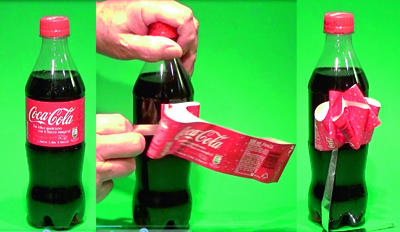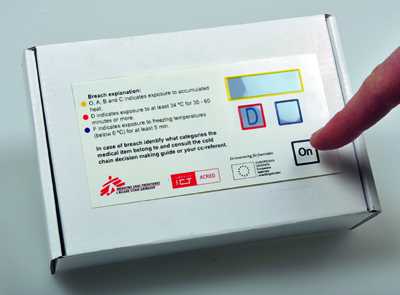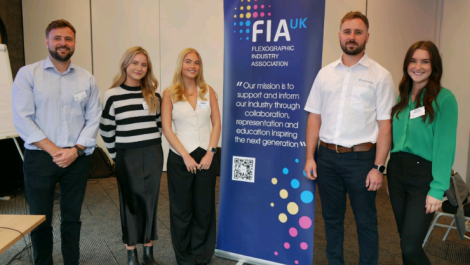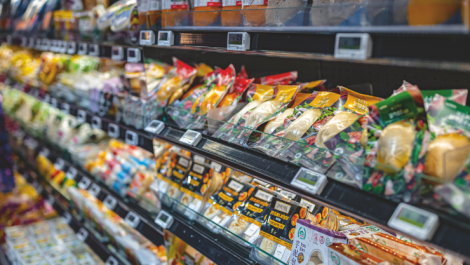With consumer expectations of a more interactive shopping experience increasingly the norm, packaging needs to be heard as well as seen, reports Des King.
We’re asking so much more of our packaging these days. Time was when a bag or a carton was simply required to protect, to preserve, to promote – and to do so at a price that wasn’t prohibitive. That changed when brand owners woke up to the potential benefits that could be realised via their packaging within a media neutral marketing culture.
With catch up and streaming via the internet reducing the pulling power exercised by TV advertising, the one sure medium through which to introduce consumers to products is the supermarket shelf. Packaging morphed from its role of standing and waiting to serve to a position of greater prominence centre stage; the taking on of greater responsibility within the marketing mix – aligned with requirement, real or perceived, to dispense ever increasing volumes of regulatory and content-oriented information – bringing in its wake the need to become far more proactive in shaping the relationship between consumer and product.
In short, packaging needs to be the possessor of far more than just a pretty face; it needs to have the brains – and the social skills – to more fully interact.
Origin of the species
As a descriptive for the added value with which contemporary packaging is increasingly empowered, interactivity has become largely synonymous with smart technology. Whilst the correlation is staring us in the face on an everyday basis from the supermarket shelf, it is the latest stage of an evolutionary process that easily predates the invention of the silicon chip, said leading consumer packaging consultant, Andrew Streeter, whose new innovātus website focuses specifically on current developments in interactivity (www.innovatus.co.uk).
‘Interactivity has become a bit of a buzzword that I can imagine design agencies using when they want to rack up their agenda and profile. However, packaging has always been interactive; that capability has just been redefined as something a bit more technical. In reality, it’s the natural legacy of convenience.
‘There’s interactivity that facilitates the way in which the consumer engages with the product, often in terms of accessing it,’ he added. ‘Then there’s interactivity that is about the brand values of the product; perceived as opposed to real ones, or those that are at least directly part and parcel of the actual content itself.’
Dazzling though the temperature-sensitive thermochromic inks might be that let you know when your lager is perfectly chilled, for example, their introduction into the packaging mix is merely the latest staging-post on the supply chain’s continuing quest to provide the ultimate in terms of customer satisfaction, observed Mr Streeter.
‘There’s a sea-change underway to provide more functionality in the pack, and a key way of achieving that is through greater interactivity. Scattered around that central principle are different facilitating technologies, whose application is dependent on getting the unit cost right plus, and quite critically, being in sync with consumer acceptance.
‘Interactivity doesn’t have to be smart to succeed; but it needs to function intuitively and provide interactivity that naturally integrates into the consumer’s life style. There’s no value in smart packaging for its own sake; it has to deliver a real practical value. Failure occurs when a technology or an enabling mechanism arrives too early onto the market.’
A notable example of a technology ahead of its time that has had to kick its heels whilst waiting for an application worth its salt is, of course, digital print.

Coca-Cola’s Christmas ‘bow tie’ label requires interaction from the consumer
Fun or functionality
Augmented reality (AR) has arguably be mired in much the same cul-de-sac, but with a new visual browser app now ready to download from the technology’s leading exponent the way ahead could very soon be a lot clearer.
The new Blippar AR app allows users to simply look at an object through the camera on their smartphone or tablet to activate an instantaneous digital search and draw information about that object from the web. Whilst the UK-originated company has targeted this new capability for all English-language album covers, fiction books, DVD covers and film posters, its ultimate aim is to make everything ‘blippable’ not least packaging.
That, of course, is already happening with campaigns for the likes of Coca-Cola, PepsiCo, Unilever and L’Oréal under its belt. In these pioneering application days, just the very presence of a Blippar portal can do wonders for even the least dynamic of commodities. Whilst even its staunchest advocates would be forced to admit that bottled water is hardly the most exciting product you’re likely to encounter down the supermarket aisle, endow it with an app-accessible digital dimension and it transforms into something a lot more special – as is the case with the ‘District Perrier’ campaign currently running within selected off-trade retail outlets in greater urban conurbation areas.
Blip onto the on-pack icon and the consumer can access a host of information and activities related to the brand including cocktail recipes, online games and social media engagement, said Blippar’s US creative lead Cheena Jain. ‘We were able to add a lot of detail within the blipp to allow users to enter a dimensional world. The two features we are very excited about are the Shake It Up and Mix It Up portions. Giving the user the ability to shake their phone like a cocktail shaker to reveal a recipe is an innovative way to highlight the overall concept and add fun, but also presents recipes in a refreshing way. Using the bottle as a gateway to District Perrier was a great opportunity, and the various audio segments really help bring the concept to life even more.’
For any brand owner thinking to go the Blippar route, initial investment in order to get up and running is a surprisingly good value entry level of circa £10,000 upwards to create and code the experience depending on how complex the interactivity might be. Once the consumer has passed through that portal it could lead to learning more about the brand; it could be downloading Spotify tracks; it could be entering into a competition. Thereafter, cost is dependent upon the volume of blipps registered during the course of the AR campaign; a recent project for PepsiCo totalling over a quarter of a million.
Whether it is providing information or entertainment, this level of interactivity is above all else designed to establish or strengthen brand loyalty. It will become the norm, said Andrew Streeter. ‘There’s any number of brands out there, so the question will be which one of them is going to have that level of interactivity that we all love the most; which inspires the greatest amount of loyalty; and which by default are seen as merely commonplace.
‘There are all the usual challenges of packaging as we go into that next stage; can you afford to own your own branded (patented) interactivity or are you going to rely upon that being provided for you by the packaging industry – and so for it to be equally available to your competitors.’
Safe but sure
Interactivity of a different magnitude is that between the pack and its contents; again, hardly new in principle – think barrier films, scavengers and modified atmosphere packaging – but becoming increasingly sophisticated through the application of new, smart technologies.

Temperature sensitive labelling from Swedish printed electronics specialist Acreo
Whilst thermochromic inks are great when it comes to delivering that perfectly chilled can of lager, they are less useful as an on-pack guide to when a product is potentially unsafe to consume. This is the issue currently being addressed by Edinburgh-based UWI Technology via a printed label that acts as clock that counts down in time with a product’s life expectancy. ‘It’s a multi-layer film solution incorporating a tiny reservoir of fluid calibrated to run at a pre-determined rate, the seal of which is broken when the pack is first opened,’ explained CEO Peter Higgins.
‘We all know that although a product might say ‘use within x days / weeks of opening’ it could be perfectly viable for far longer. Sniffing it to see that it’s still OK is unreliable; you can’t smell salmonella. The presence of a green light would be immensely reassuring.’
The technology operates independently of pack contents and can be adapted to react to differences caused by temperature changes from -1º C up to +40º C. It can be licensed on an application by application basis to appropriately equipped packer/fillers or converters, said Mr Higgins. ‘We’ve deliberately gone down the print route so that we can achieve a high volume/low cost ratio. The unit cost is 10-15p to manufacture, but we know that it wouldn’t be feasible at anything above 2p. Given sufficient scale that’s definitely achievable. Independent research we’ve had done shows that additional cost to be easily affordable from a consumer perspective, especially for say children’s food products.’
A label developed by the Swedish printed electronics specialist Acreo that interacts with changes of external temperature is currently being trialled by Médecins Sans Frontières (MSF). The temperature sensor consists of printed components and silicon chip, forming an integrated measuring system for the monitoring of temperatures. This sensor system can track if a package with sensitive drugs, such as vaccine, has been exposed to temperatures outside a predefined interval. The result is presented on the integrated display.
‘The potential with the printed sensor is tremendous and will provide a much better aid allowing the end-user to determine if the product is usable or not,’ said Marpe Tanaka at the MSF Innovation Unit. ‘The further out into the field you are, the harder it is to maintain the right temperature in the logistic chain which is vitally important in maintaining the quality of the vaccine or the medicine. In the end it affects the care we give our patients. Other alternative transport solutions available today are often very expensive.’






